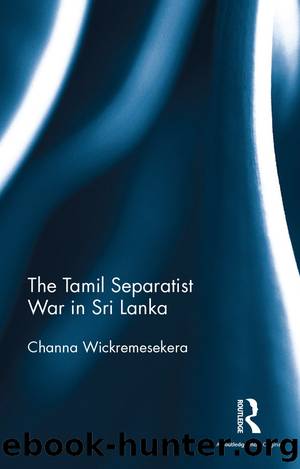The Tamil Separatist War in Sri Lanka by Channa Wickremesekera

Author:Channa Wickremesekera [Wickremesekera, Channa]
Language: eng
Format: epub
ISBN: 9781138488731
Google: 7ISxswEACAAJ
Publisher: Taylor & Francis Group
Published: 2018-01-15T16:13:09+00:00
Operation Jayasikurui
After the capture of Kilinochchi, speculation was rife about a big military push to link Vavuniya with Kilinochchi. Despite the loss of Mullaithivu and the high price paid for Kilinochchi, there was still a surfeit of optimism in government circles. The armed forces now stood at around 95,000 including recalled reservists. The government had also spent heavily on weapons in 1996â97, purchasing an additional 15 main battle tanks from the Czech Republic and 14 patrol craft (nine Super Dvoras from Israel and five Trinity Class ships from the US) and another medium-size landing craft from China. More APCs (BTR80) and 152 mm guns were also expected shortly from China.27 The Tigers, despite their recent performance in the Wanni, were not believed to number more than 6,000.28 The lack of serious resistance to Operation Edibala was also seen in defence circles as an indication that the rebels were desperately weak.29
The big push finally came on May 17. Code named âOperation Jayasikuruiâ or âVictory Assuredâ, it involved a northwards thrust along the A9 towards Kilinochchi by nearly 20,000 troops belonging to the Fifty-Fifth and Fifty-Third Divisions. The Fifty-Fifth had been raised specifically for this campaign. It included the Commando, Special Forces and Airmobile Brigades. The Twenty-Third was pulled out of Jaffna to be redeployed. The troops also included a contingent of naval troops trained in guerrilla warfare.30
Initially, the advance was along two axes: the Fifty-Fifth Division advanced northwards along the A9, while the Fifty-Third broke out of the defences in Janakapura in the Weli Oya area and moved in a north-westerly direction towards the PuliyankulamâMullaithivu road.
The operation had all the hallmarks of previous incursions into the Wanni. It was another âjungle bashing operationâ but in far greater strength than ever before. Along with the advancing columns went a fleet of earth moving machines, many of which had been acquired for this operation. They cut through the scrub, clearing a path for the armour and the infantry to advance. The Fifty-Fifth Division moved in two columns, about half a kilometre on either side of the A9, avoiding the road for fear of landmines.31 As the troops advanced, artillery began pounding enemy targets in the Wanni from the armyâs bases in Vavuniya, Weli Oya and Kilinochchi. In the sky, surveillance and ground-attack aircraft circled, watching for signs of enemy presence.
The operation began promisingly, the columns advancing briskly in the first few days. But soon resistance began to stiffen, the rebels counter-attacking fiercely, launching a series of counter-attacks code named âdo or dieâ, using large numbers of troops. It was not until August 6 that the troops from Fifty-Third and Fifty-Fifth Divisions were able to finally link up about 2 km south of Puliyankulam.32 By then, the Tigersâ strategy was becoming clear. They were not going to melt into the jungle as in the case of previous army incursions into the region. Instead, they were going to bleed the army dry, exacting a heavy toll in lives and hardware as they fell back gradually. They were also aiming to strengthen themselves by capturing as much booty as they could.
Download
This site does not store any files on its server. We only index and link to content provided by other sites. Please contact the content providers to delete copyright contents if any and email us, we'll remove relevant links or contents immediately.
The Radium Girls by Kate Moore(10914)
The Templars by Dan Jones(4192)
100 Deadly Skills by Clint Emerson(4084)
Rise and Kill First by Ronen Bergman(4017)
The Doomsday Machine by Daniel Ellsberg(3736)
The Rape of Nanking by Iris Chang(3525)
Killing England by Bill O'Reilly(3459)
Hitler in Los Angeles by Steven J. Ross(3444)
Stalin by Stephen Kotkin(3089)
12 Strong by Doug Stanton(3059)
Hitler's Monsters by Eric Kurlander(2736)
Darkest Hour by Anthony McCarten(2650)
Blood and Sand by Alex Von Tunzelmann(2611)
The Art of War Visualized by Jessica Hagy(2416)
Hitler's Flying Saucers: A Guide to German Flying Discs of the Second World War by Stevens Henry(2298)
The Code Book by Simon Singh(2215)
The Second World Wars by Victor Davis Hanson(2136)
Babylon's Ark by Lawrence Anthony(2073)
Tobruk by Peter Fitzsimons(2064)
